LPG Heater Guide – Portable Gas Heaters – Flued Gas Heaters – Unflued Gas Heaters
LPG Heaters – Gas Bottle Heater – Gas Heater for Home
An LPG heater is a gas heater for home, heating a room or outdoor area using an LPG gas heater fueled by propane or butane.
Indoor LPG heaters (gas heater for home) include unflued gas heaters, flued gas heaters, radiant LPG heaters, convector LPG heater, radiant-convector LPG gas bottle heater, and gas heater fireplaces.
Unflued Gas Heaters (LPG Heaters) – Flueless – Portable Gas Heaters (LPG Heater)
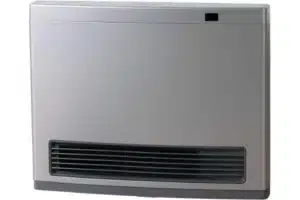
Portable gas heaters (unflued gas heaters) have no flue and discharge the combustion gases and water vapour straight into the room.
Most unflued gas heaters (LPG heaters) can be moved between rooms, as they have a gas hose that plugs into a floor or wall bayonet socket.
Some unflued gas heaters (portable gas heaters) are fixed in place to the wall.
Most unflued gas heaters (gas heater for home) have a 3m long hose to plug them in to a bayonet socket and can be moved from room to room.
These are more commonly called portable gas heaters (gas bottle heater).
Portable gas heaters (LPG heaters) or unflued gas heaters (gas heater for home) or are typically much more energy efficient than flued gas heaters (LPG heater) for the home and have higher Energy Star ratings, as there is no heat loss through a flue.
Further, as unflued gas heaters (portable LPG gas heaters) are ventless and don’t use flue kit the installation is much faster and economical.
Since unflued gas heaters (LPG heaters) vent combustion gases and water vapour directly into the room of their use, they could cause indoor air pollution that may have adverse health effects.
The maximum levels of gases released by portable LPG heaters (unflued gas heaters) are specified by government safety regulations.
Flued Gas Heaters – Fixed LPG Heaters (Gas Heater for Home)
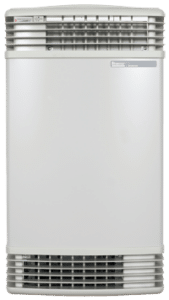 Flued gas heaters (fixed gas heater for home) direct combustion gases out of your home through a wall, flue pipe or chimney.
Flued gas heaters (fixed gas heater for home) direct combustion gases out of your home through a wall, flue pipe or chimney.
This means that flued gas heaters (LPG heaters) do not emit combustion gas nor water vapour inside the home.
They are available as natural gas and LPG flued gas heaters (fixed LPG heaters).
Flued gas heaters (LPG heater) are also available in direct vent or balanced flue models that draw the combustion air from outside your home, so there are less drafts.
The amount of air drawn in is balanced with the exhaust gas that goes out the flue.
Flued gas heaters (fixed LPG heaters) are less energy efficient than unflued gas heaters (portable gas heaters).
Some flued gas heaters (fixed LPG heaters) have a powered flue, which are fixed flued gas heaters (LPG heaters) with an electric fan driving the gases out of the home.
Flued gas heaters (gas heater for home) tend to cost more than unflued gas heaters (gas bottle heater) because of the extra flue hardware and installation required.
They are available in a range of sizes.
Be aware that flued gas heaters (fixed gas heater for home) do have lower Energy Star ratings, as there is some heat loss through the flue.
Gas fitters know how to install flued gas heaters (LPG heaters) and can quote you on flued gas heaters (LPG heater) installation cost.
Indoor Emissions – Are Unflued Gas Heaters (LPG Heaters) or Portable Gas Heaters Safe
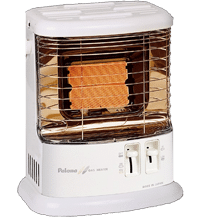 The term “flued” refers to the fact that the combustion gases generated when the gas is burnt are directed out of your home by flued gas heaters (fixed LPG gas heater for home) having a flue pipe through the wall or ceiling.
The term “flued” refers to the fact that the combustion gases generated when the gas is burnt are directed out of your home by flued gas heaters (fixed LPG gas heater for home) having a flue pipe through the wall or ceiling.
As a result, there are no emissions in your home with flued gas heaters (fixed LPG heaters).
Care should be taken when using unflued gas heaters (portable gas heaters) if the family includes very young, unborn, elderly or individuals with some medical conditions, as they may be more sensitive to the emissions.
However, for the majority of people, unflued gas heaters (portable gas bottle heater) are quite safe when you follow all of the manufacturer’s safety instructions, including providing adequate ventilation.
Energy Efficiency & Operating Costs of Unflued Gas Heaters vs Flued Gas Heaters (LPG Heaters)
Portable gas heater for home (unflued gas heaters) are more efficient than flued gas heaters (LPG heaters) because some of the heat is lost through the flue.
The typical Star Ratings for unflued gas heaters (portable gas heaters) are from 5.8 to 5.9 Stars, meaning that they are about 90% efficient in converting the gas to usable heat.
Flued gas heaters (fixed LPG gas heater for home) can have a broad range of performance, with Star Ratings from 1.0 to 4.8 Stars.
Flued gas heaters (LPG heater) equate to 61% to 84% efficiency levels.
This means is that you could save as much as 32% of the cost of heating by choosing portable gas heaters (unflued gas bottle heater) compared with some flued gas heaters (LPG heaters) – fixed LPG gas heater for home (LPG heater).
Portability of Unflued Gas Heaters (LPG Heaters)
Unflued gas heaters (portable LPG gas heater for home) can be moved where needed, from one room to another, as long as each room has an LPG heater bayonet connection.
This is why they are commonly referred to as portable gas heaters (LPG heaters).
The portable gas heaters (gas bottle heater) plug into the LPG heater (LPG heaters) bayonet connection via a gas bayonet hose.
This also allows you to rotate the direction of portable LPG gas heater for home (unflued gas heaters), to aim the heat at or away from a particular part of the room.
On the other hand, flued gas heaters (LPG heaters) are fixed in place by the gas connection and flue.
LPG Heaters (LPG Heater) & Moving Home
Unflued gas heaters (portable LPG gas heater for home) are much easier to take with you when you move than flued gas heaters (fixed LPG heaters).
You simply disconnect it from the LPG heater (gas heater for home) bayonet connection and go.
Moving flued gas heaters (fixed LPG heaters) requires a gas fitter to uninstall the unit and reinstall it for the new home.
There is also the issue of the flue hole in the wall or ceiling if you remove flued gas heaters (LPG heaters).
In addition, most home buyers would consider flued gas heaters (fixed LPG heater) to be a built-in appliance and expect it to remain with the house.
Comparison of Flued Gas Heaters vs Unflued Gas Heaters (LPG Heaters) Purchase Cost
Flued gas heaters for the home (flued LPG heaters) are more expensive to purchase than a portable LPG gas heater for home (unflued gas bottle heater).
For example, when comparing comparably sized flued gas heaters (fixed LPG heater) and portable gas heaters (unflued gas heaters), the flued gas heaters are 44% to 57% more expensive* than the unflued gas heaters.
Depending on the model and installation situation, you may also need to purchase an accessory flue kit when you install flued LPG heaters.
*These numbers can vary by model, brand and over time.
Installation Cost of Unflued Gas Heaters vs Flued Gas Heaters (LPG Heaters)
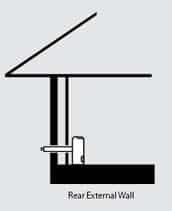 If you already have an LPG gas heater (LPG heater) bayonet connection in your home, there is no cost to install unflued gas heaters (portable gas heaters).
If you already have an LPG gas heater (LPG heater) bayonet connection in your home, there is no cost to install unflued gas heaters (portable gas heaters).
So, while not prohibitively expensive, it does cost more to install flued gas heaters (flued LPG heaters) than unflued gas heaters (portable gas heaters).
Even if you need to add an LPG gas heater (LPG heater) bayonet connection, the installation costs for portable gas heaters (unflued gas heaters) would be modest.
Installation of flued gas heaters (fixed LPG heaters) in your home requires the services of a gas fitter in all circumstances.
There is also the cost of installing the flued gas heaters (LPG heaters) flue kit through the wall or ceiling.
What Size LPG Heater Do I Need?
LPG heaters (LPG heater) size depends on the following factors
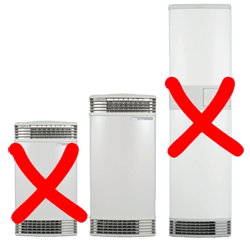 ♦ The volume of the area to be heated including consideration of ceiling height.
♦ The volume of the area to be heated including consideration of ceiling height.
♦ The climate zone that you live in.
♦ The physical features of your home including wall & ceiling insulation, window coverings and carpeting.
♦ The kW output of the LPG gas heater for home (LPG heaters), not to be confused with the gas MJ input.
LPG Heater Area Volume & Climate Zone
The required kW output required is primarily dependent upon the area to be heated and the climate zone in which you live.
Energy Efficiency Matters for LPG Heaters – Star Ratings
 LPG gas heater for home (LPG heater) has Energy Star Ratings that equate to energy efficiency.
LPG gas heater for home (LPG heater) has Energy Star Ratings that equate to energy efficiency.
So, remember to use kW as a comparison and not MJ.
The efficiency of the LPG gas heater for home (LPG heater), in converting gas energy to heat, is a key factor.
For example, a 25MJ LPG heater (LPG heaters) with a 5.8 Star rating has an output of 6.2kW.
A 25MJ LPG gas heater (gas bottle heater) with a 2.8 Star rating only has an output of 5.0kW.
As a result, in a Cold Zone climate, they would heat 62m² and 50m², respectively.
This means that the 5.8 Star LPG gas heater for home (LPG heater) will heat an area 24% larger while using the same amount of gas.
Please refer to the manufacturers’ specifications to determine the exact kW output for each LPG heater (gas bottle heater) you are considering.
Minimum Room Sizing
Some States specifiy the minimum room sizing (volume of room in M³) and minimum ventilation requirements for unflued gas heaters (LPG heaters).
Minimum room sizing also varies between thermostatically controlled and manually controlled LPG gas heater for home (LPG heater).
Portable gas heaters (gas bottle heater) should not be used in bedrooms, bathrooms or hallways.
All installations must comply with Australian Standard AS5601 – Gas Installations.
Your gas fitter will be able to guide you on many of these points.
Manufacturer Sizing Charts
To make it even easier, most manufacturers have sizing charts, for their LPG heaters (LPG heater), based on climate zone maps.
Take the time to measure the area you wish to heat and use these charts and maps to get the correctly sized LPG gas heater for home (LPG heater).
It is always wise to follow the manufacturers’ advice.
New Residential LPG customer?
New Business LPG customer?
Existing ELGAS customer?
- Butane – Butane Gas – Butane Chemical Formula- Butane Gas Canister - April 23, 2025
- BBQ – Gas and Charcoal BBQ Features – Charcoal BBQ vs Gas BBQ Comparison - March 31, 2025
- GPL Gas (GPL Fuel) – GLP Gas – LPG Gasul: GLP – GPL Station Near Me - March 26, 2025
Steve Reynolds
Technical Consultant
Steve Reynolds is a leading expert in the LPG industry with over 22 years of experience. As part of the national management team at ELGAS, Steve ensures the safe and efficient storage, handling, and transportation of LPG. He serves as the lead investigator for incidents and collaborates with authorities on industry developments.
Steve is a technical advisor to Standards Australia and Gas Energy Australia (GEA), and an active member of the World LPG Association (WLPGA), contributing to global standards and technical reviews. He holds a BSc. (Hons) in Industrial Chemistry from UNSW and has held senior safety and technical roles at ELGAS, making him a trusted authority in LPG safety and standards.
